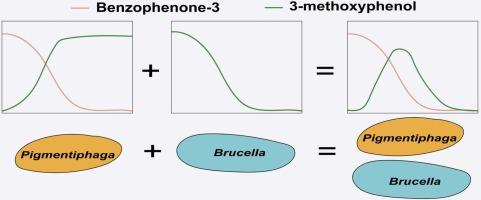Synergistic mineralization of the UV filter benzophenone-3 by a cross-feeding consortium from wastewater treatment plants: Insights into novel pathway and bioremediation strategy
IF 11.3
1区 环境科学与生态学
Q1 ENGINEERING, ENVIRONMENTAL
引用次数: 0
Abstract
Benzophenone-3 (BP-3), used as an organic UV filter in diverse consumer products including cosmetics, has been frequently detected in wastewater treatment plants (WWTPs) and aquatic environments. BP-3 and its transformation products are regarded as emerging micropollutants due to their low biodegradability. Here, we investigate the synergistic degradation of BP-3 by a bacterial consortium seeded from aerobic sludge WWTPs. BP-3 is found to be initially degraded through a novel pathway involving a C-C bond cleavage step, producing intermediates 3-methoxyphenol (3MOP) and benzoate, two naturally occurring compounds which can be readily degraded in the environment. Metagenome-guided pure culture isolation and pathway analysis reveal that bacterial strains from genera Pigmentiphaga and Brucella synergistically contribute to the BP-3 mineralization. Specifically, the Pigmentiphaga strain degrades BP-3 into benzoate and 3MOP, with the former being utilized by itself and the latter utilized by the Brucella strain. A reconstructed consortium, consisting of two isolated strains from Pigmentiphaga and Brucella, exhibits similar degradation performance to that of the natural consortium, indicating their crucial roles in environmental BP-3 degradation. These findings provide new insights into BP-3 biodegradation at the microbial community level, offering potential strategies for wastewater treatment applications by manipulating synthetic microbial consortia.

来自污水处理厂的交叉饲养财团对紫外线过滤器二苯甲酮-3的协同矿化:新途径和生物修复策略的见解
二苯甲酮-3 (BP-3)在包括化妆品在内的各种消费品中用作有机紫外线过滤器,在污水处理厂(WWTPs)和水生环境中经常被检测到。BP-3及其转化产物生物降解性较低,被认为是新兴的微污染物。在这里,我们研究了由好氧污泥污水处理厂培养的细菌联合体对BP-3的协同降解。BP-3最初通过一种新的途径降解,包括C-C键裂解步骤,产生中间体3-甲氧基酚(3MOP)和苯甲酸酯,这两种天然存在的化合物很容易在环境中降解。宏基因组引导下的纯培养分离和途径分析表明,来自Pigmentiphaga属和布鲁氏菌属的菌株协同促进BP-3矿化。具体而言,Pigmentiphaga菌株将BP-3降解为苯甲酸盐和3MOP,前者被自身利用,后者被布鲁氏菌利用。由两个从Pigmentiphaga和Brucella分离的菌株组成的重组菌群显示出与天然菌群相似的降解性能,表明它们在环境BP-3降解中起着至关重要的作用。这些发现为BP-3在微生物群落水平上的生物降解提供了新的见解,并通过操纵合成微生物群落为废水处理应用提供了潜在的策略。
本文章由计算机程序翻译,如有差异,请以英文原文为准。
求助全文
约1分钟内获得全文
求助全文
来源期刊

Journal of Hazardous Materials
工程技术-工程:环境
CiteScore
25.40
自引率
5.90%
发文量
3059
审稿时长
58 days
期刊介绍:
The Journal of Hazardous Materials serves as a global platform for promoting cutting-edge research in the field of Environmental Science and Engineering. Our publication features a wide range of articles, including full-length research papers, review articles, and perspectives, with the aim of enhancing our understanding of the dangers and risks associated with various materials concerning public health and the environment. It is important to note that the term "environmental contaminants" refers specifically to substances that pose hazardous effects through contamination, while excluding those that do not have such impacts on the environment or human health. Moreover, we emphasize the distinction between wastes and hazardous materials in order to provide further clarity on the scope of the journal. We have a keen interest in exploring specific compounds and microbial agents that have adverse effects on the environment.
 求助内容:
求助内容: 应助结果提醒方式:
应助结果提醒方式:


